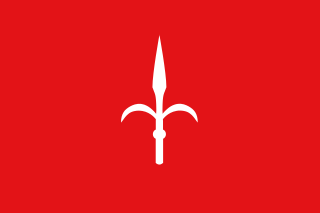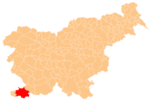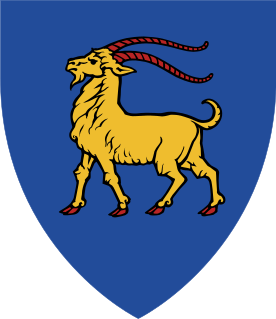
Istria, formerly Histria (Latin), Ίστρια, is the largest peninsula in the Adriatic Sea. The peninsula is located at the head of the Adriatic between the Gulf of Trieste and the Kvarner Gulf. It is shared by three countries: Croatia, Slovenia, and Italy. Croatia encapsulates most of the Istrian peninsula with its Istria County.
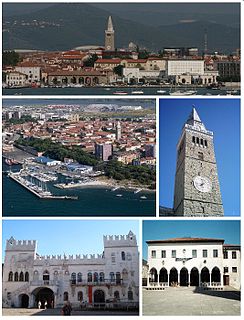
Koper is the fifth largest city in Slovenia. Located in the southwestern part of the country, approximately five kilometres south of the border with Italy and 20 kilometers from Trieste, Koper is the largest coastal city in the country. It is bordered by the satellite towns of Izola and Ankaran, and anchors the Istrian region. With a unique ecology and biodiversity, it is considered an important national natural resource. It is the oldest recorded urban settlement in Slovenia. The city's Port of Koper is the major contributor to the economy of the eponymous city municipality. With only one percent of Slovenia having a coastline, the influence that the Port of Koper also has on tourism was a factor in Ankaran deciding to leave the municipality in a referendum in 2011 to establish its own. The city is a destination on a number of Mediterranean cruising lines. In 2016, the city expects 65 cruise ship arrivals with the season spanning from March to December. Koper is the main urban centre of the Slovenian Istria, with a population of about 25,000.

Izola is an old fishing town and a municipality in southwestern Slovenia on the Adriatic coast of the Istrian peninsula. Its name originates from the Italian Isola, which means 'island'.

Piran is a town in southwestern Slovenia on the Gulf of Piran on the Adriatic Sea. It is one of the three major towns of Slovenian Istria. The town has much medieval architecture, with narrow streets and compact houses. Piran is the administrative centre of the local area and one of Slovenia's major tourist attractions. Until the mid-20th century, Italian was the dominant language, but was replaced by Slovene as demographics shifted.

The Morgan Line was the line of demarcation set up after World War II in the region known as Julian March which prior to the war belonged to the Kingdom of Italy. The Morgan Line was the border between two military administrations in the region: the Yugoslav on the east, and that of the Allied Military Government on the west. After 15 September 1947, the Allied Military Government was composed of both the British Element Trieste Forces (BETFOR) troops from the United Kingdom and the Trieste United States Troops (TRUST) from the United States.

San Dorligo della Valle is a comune (municipality) in the Province of Trieste in the Italian region Friuli-Venezia Giulia, located about 4 kilometres southeast of Trieste, on the border with Slovenia. As of 31 December 2004, it had a population of 6,019 and an area of 24.5 square kilometres (9.5 sq mi). According to the 1971 census, 70.5% of the population are ethnic Slovenes, while the rest are mostly Italians.

Slovenia has been a meeting area of the Slavic, Germanic, Romance, and Uralic linguistic and cultural regions, which makes it the most complex meeting point of languages in Europe. The official and national language of Slovenia is Slovene, which is spoken by a large majority of the population. It is also known, in English, as Slovenian. Two minority languages, namely Hungarian and Italian, are recognised as co-official languages and accordingly protected in their residential municipalities. Other significant languages are Croatian and its variants and Serbian, spoken by most immigrants from former Yugoslavia and their descendants. Slovenia is ranked among the top European countries regarding the knowledge of foreign languages. The most often taught foreign languages are English and German, followed by Italian, French, and Spanish.
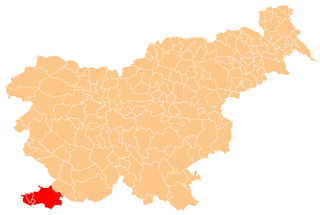
The Italian language is an officially recognized minority language in Slovenia, along with Hungarian. Around 3,700 Slovenian citizens speak Italian as their mother tongue. Italian has a strong presence in Slovenia, both historical and current. An estimated 15% of Slovenians speak Italian as a second language, which is one of the highest percentages in the European Union.

Slovene Lands or Slovenian Lands is the historical denomination for the territories in Central and Southern Europe where people primarily spoke Slovene. The Slovene Lands were part of the Illyrian provinces, the Austrian Empire and Austria-Hungary. They encompassed Carniola, southern part of Carinthia, southern part of Styria, Istria, Gorizia and Gradisca, Trieste, and Prekmurje. Their territory more or less corresponds to modern Slovenia and the adjacent territories in Italy, Austria, Hungary, and Croatia, where autochthonous Slovene minorities live. In the areas where present-day Slovenia borders to neighboring countries, they were never homogeneously ethnically Slovene.

Cerej is a settlement next to Hrvatini in the City Municipality of Koper in the Littoral region of Slovenia, right on the border with Italy.

Spodnje Škofije is a settlement in the City Municipality of Koper in the Littoral region of Slovenia. A major border crossing on the Highway 5 into Italy is located here, with the Italian side known as Rabuiese.

Plavje is a village in the City Municipality of Koper in the Littoral region of Slovenia. It is located on the northernmost edge of the Istrian peninsula, on the border with Italy, on a small hill overlooking the Gulf of Trieste.
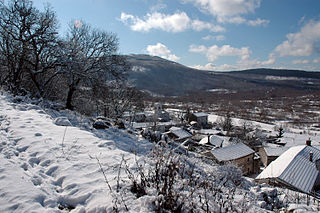
Podgorje is a village in the City Municipality of Koper in the Littoral region of Slovenia on the border with Croatia.

Socerb is a village in the City Municipality of Koper in the Littoral region of Slovenia. It lies on the border with Italy and is dominated by the ruins of Socerb Castle, built on a rocky cliff above the village.

Opatje Selo is a village in the Municipality of Miren-Kostanjevica in the Littoral region of Slovenia, right on the border with Italy. It is located on the Karst Plateau, along an old road leading from Komen to Gorizia. It includes the former hamlet of Mačeče.

Jelšane is a village in the Municipality of Ilirska Bistrica in the Inner Carniola region of Slovenia, right on the border with Croatia. The Jelšane international border crossing between Slovenia and Croatia is just south of the village.

Slovene Istria is a region in southwest of Slovenia. It comprises the northern part of the Istrian peninsula, and it is part of the wider geographical-historical region known as the Slovene Littoral (Primorska). Its largest urban center is Koper. Other large settlements are Izola, Piran and Portorož. The whole region has around 120 settlements. In its coastal area, both the Slovene and Italian languages are official.

The Slovene Riviera is the coastline of Slovenia, located on the Gulf of Trieste, by the Adriatic Sea. It is part of the Istrian peninsula and is 46.6 km long. The region comprises the towns of Koper and Piran with Portorož, and the municipality of Izola. It is a seaside tourist destination, with a vibrant multiethnic Slovenian and Italian heritage.









